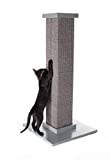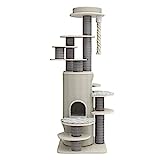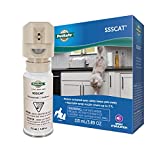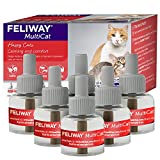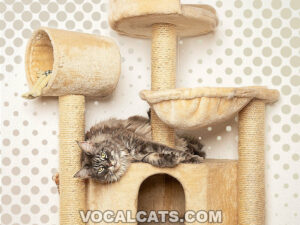Do Ragdoll Cats Scratch Furniture? Yes, Ragdoll Cats do Scratch Furniture. No matter how laid-back and docile Ragdolls are, they will scratch Furniture. However, they aren’t as aggressive as other cat breeds. Ragdoll owners need not worry because Scratching Furniture is a normal behavior. Ragdoll Cats are playful. They view Furniture as a toy to play with.
Scratching is an innate and normal cat behavior, meaning, all cats, including the affectionate Ragdolls, have the urge to Scratch things. Aside from scratching as a form of play, the behavior is also associated with territorial marking, grooming, flexing those muscles, or venting out their emotions.
In this article, we will discuss in depth the reasons why Ragdolls Scratch Furniture. We’d also provide you with solutions on what to do to stop your Ragdoll from scratching your couch, carpet, and other Furniture.
Contents
- Will Ragdoll Cat Scratch Furniture?
- Do Ragdoll kittens Scratch Furniture?
- Do Ragdoll Cats Scratch and bite?
- Do Ragdoll Cats Scratch a lot?
- Do Ragdoll Cats Scratch people?
- How do I stop my Ragdoll Cat from Scratching Furniture?
- Ragdoll Scratching Furniture! 5 Ways to keep your Ragdoll Cat From Scratching Furniture
- Is a Ragdoll a good cat?
- So why won’t my Ragdoll stop Scratching the Furniture?
- Are Ragdoll cats destructive?
- So, do Ragdoll Cats Scratch Furniture?
- Related Questions
Will Ragdoll Cat Scratch Furniture?

Yes, Ragdoll Cat will Scratch Furniture. When you see a Ragdoll cat Scratch Furniture, it is an instinctual behavior that is inherited from his ancestors.
Here are some of the reasons why Ragdolls Scratch furniture:
1. Territorial Marking
Cats use the power of scent to communicate. In the wild, cats spend a lot of time in solitude and most of their communication is done in the form of territorial marking.
The paw pads of cats contain powerful scent glands that leave a unique odor every time cats scratch or rub on anything. So, essentially, it’s their way of telling the other guys to back off from a specific spot.
And, up to this day, Ragdoll Cats Scratch Furniture as a way of claiming that piece of property. Moreover, mating season exacerbates the scratching behavior because it is their way of letting the opposite gender know of their readiness for mating and reproduction.
READ ALSO: Cat Scratching Litter Box Excessively: 10 Reasons Why & What To Do!
2. Grooming
Cats are fastidious groomers. They spend a large chunk of their time licking their coats to keep them clean. The same is true with their nails, Ragdoll Cats enjoy having their nails done in the form of Scratching a Furniture.
Scratching on coarse surfaces removes the outer and dull husks from their nails, thereby, keeping those nails smooth, sharp, and hygienic.
3. Yoga Stretching
We, humans, know what a good stretch does to our bodies – it keeps our muscles flexible and healthy. The same is true for Ragdoll Cats.
It may seem like they are wrecking our Furniture but in reality, Ragdolls are engaging in some ‘yoga poses’ to stretch those muscles, joints, and tendons.
Additionally, since Ragdolls are lazy and sleep a lot. Scratching Furniture upon waking up is the perfect way to increase blood circulation and warm up their bodies for some playtime action.
RECOMMENDED: Why Does My Cat Sleep On My Pillow? 13 Reasons Why!
4. To Relieve Anxiety
Ragdoll Cats that are bored, stressed out, or overwhelmed with loneliness do things to relieve anxiety. One of those is scratching Furniture. It is a great form of entertainment to keep their minds busy and away from ‘negative thoughts.’
Do Ragdoll kittens Scratch Furniture?
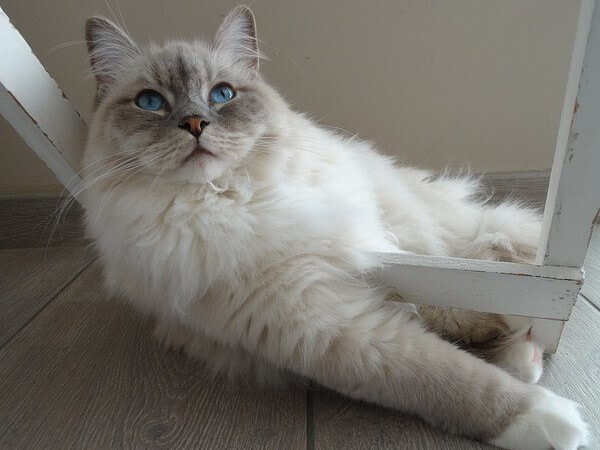
Yes, Ragdoll kittens do Scratch Furniture. As early as 8 weeks of age, Ragdolls begin to Scratch Furniture as a form of play. Kittens are beaming with excitement and curiosity and they release pent-up energies by playing with their littermates.
Furniture such as a sofa and textured throw pillows are very attractive for kittens to play with.
Do Ragdoll Cats Scratch and bite?
Similar to other breeds, Ragdoll Cats do Scratch and bite. Ragdolls will Scratch Furniture but due to their gentle nature, it’s unlikely that they will cause significant damage.
Will Ragdoll Cats bite? No, it’s because this breed is one of the gentlest and mild-mannered cats. So, it’s not in their genes to show any forms of aggression like biting.
Do Ragdoll Cats Scratch a lot?
No, Ragdolls do not Scratch a lot compared to other breeds. Neither do they Scratch as intense.
Do Ragdoll Cats Scratch people?

No, Ragdolls are not known to scratch people. If ever they do, it’s not intentional and may be due to excitement while playing or due to their unkempt and long nails.
How do I stop my Ragdoll Cat from Scratching Furniture?
If you’re already bothered by your Ragdoll Scratching behavior, this next section has some helpful solutions for you.
Ragdoll Scratching Furniture! 5 Ways to keep your Ragdoll Cat From Scratching Furniture
Part of Ragdoll cat care is providing them the ability to satisfy their feline needs or instincts. While scratching their claws is a natural and normal behavior seen in cats, it doesn’t mean you have to worry about your Furniture getting damaged.
Listed below are tips to mitigate this problem. These solution will give you some peace of mind regarding your Ragdoll cats clawing on things they shouldn’t.
1. Ragdoll Scratching post
A Ragdoll cat Scratching post is one of the best ideas you can provide for your precious fuzzy friends. It is easy to install with an array of products available in the market that can fit nicely indoors.
Or you can do-it-yourself (DIY) to better suit the needs of your Ragdoll cat. There are several benefits of installing a Ragdoll Scratching post that will surely reduce not just your feline friend’s stress but also your own.
- It keeps their claws healthy.
All cats, including Ragdolls, keep their claws healthy by shedding the outer claw sheaths. A cat’s claw grows in layers and removing these dead parts of the nail will expose the healthier claw underneath giving it a sharper edge.
CHECK OUT: Do Ragdoll Cats Shed? 7 Ways To Shed Less!
- It marks their territory.
When cats sharpen and extend their claws, they also release pheromones from the tiny glands in their paw pads. This scent gives them a feeling of security around the area and reassures them that they are in a safe place. It also sends a message to other cats that this particular place is their territory.
- It stimulates them physically and mentally.
One way cats keep their muscles supple is by stretching which helps blood circulation and improves their range of motion.
Having a tall scratching post is an excellent way to keep them healthy. This is especially for a large Ragdoll that is always kept indoors and has a tendency to be lazy and idle.
It also keeps Ragdoll Cats mentally engaged when other toys and features are incorporated into the post like dangling toy balls or a perch.
- It minimizes destructive behavior.
Cats get stressed the same way we humans do. And, one of the ways they get to release their emotions is through scratching.
A good Scratch not only burns off pent-up energy but also stimulates the release of endorphins which makes them feel happy and motivated.
- It’s a great meeting spot.
For a household with multiple cats, a scratching post with several tiers is a great place where they can congregate and interact with each other.
Cats, including Ragdolls, follow a certain hierarchy and some cats would assert their dominance by perching on a higher place. A scratching post or cat tree with multi-level tiers would serve this purpose.
Below are also some suggestions you can do to get your Ragdoll to use the scratching post.
- Make sure that the scratching post is sturdy and would not easily tumble.
- Place the scratching post near their favorite place.
- Lure them with cat treats or toys to let them know where to Scratch.
- Sprinkle some catnip herbs on the sides and top of the scratching post since the aroma gives them a euphoric feeling.
RECOMMENDED: How To Clean A Cat Tree (10 Easy Steps)
2. Furniture Strips
Applying an anti-scratch double-sided tape on your couch, door frame, or carpet would prevent your Ragdoll from damaging it any further.
The sticky sensation would deter any cat and would train them not to get near that particular piece of Furniture. These are typically made from medical-grade material and would not harm your Ragdoll in any way.
Another solution is to wrap aluminum foil around the area of the furniture where your Ragdoll would usually scratch. The texture and noise the foil makes are disagreeable to most cats.
3. Cat Repellent Spray
Spritzing the surface of the Furniture with some natural repellents like lemon or other citrus-based products would also do the trick. Cats are sensitive to the strong citrus smell and would train your Ragdoll to keep away from that area.
Other household items that your Ragdoll might frown upon are cinnamon, rosemary, and thyme. Oils such as tea tree oil, eucalyptus, peppermint, and clove are not recommended as sprays because these can be toxic to your Ragdoll if ingested or inhaled.
You can also try using a pet deterrent spray to discourage your Ragdoll from scratching your furniture.
When do Ragdoll kittens calm down?
While Ragdolls are known to be calm and docile, Ragdoll kittens tend to be very playful and can be a bit hyperactive which can cause a bit of mayhem to your Furniture. They tend to mellow down as they mature into adulthood around 8 to 12 months of age.
4. Calming Spray For Cats
Calming sprays that mimic pheromones also help in keeping your Ragdoll from damaging your Furniture by easing their anxiety and stress.
These sprays are odorless and safe for both cats and humans. Using these sprays is also useful in targeting other unwanted behaviors such as peeing outside of their litter box.
5. Cat toys
Letting your Ragdolls play will keep them from getting bored and anxious making it less likely for them to focus their attention on scratching your Furniture.
Playing with them for at least 15 minutes a day with interactive toys such as laser pointers or fishing pole toys keeps them entertained. These toys also allow them to release their pent-up energy.
Is a Ragdoll a good cat?
Yes, Ragdolls are great cats to own because of their easygoing and calm nature. They are not aggressive and typically get along well with most people and other cat-friendly pets.
So why won’t my Ragdoll stop Scratching the Furniture?
After you’ve employed the measures we suggested above, and your Ragdoll still hasn’t stopped scratching your Furniture, the following may be the reasons why:
1. Anxiety
Simple changes like a new person in the house or even a new type of litter may trigger anxiety. If this is the case, just give your cat enough time to get used to the new people, and objects, among others in its immediate surrounding.
DON’T MISS: Are Ragdoll Cats Talkative Or Vocal?
2. Change in routine
Ragdolls are creatures of habit. So ask yourself if you’ve initiated some changes like its feeding schedule. Or perhaps, you relocated its kitty bed or feeding bowls to a new location.
3. Not happy with the material of the scratching post
It’s also likely that your Ragdoll is not happy with its new Scratch Post. Check the fabric of the Scratch Post. It’s because some Ragdoll Cats may show a preference for a particular kind of material.
4. Scratching post is not in the right place
Sometimes your Ragdoll may still be scratching your Furniture because it is not happy with the location of the Scratch Post.
Try relocating the Scratch posts to where your Ragdoll prefers them to be.
5. Unspayed Ragdolls
The urge to leave their scents is much stronger among unneutered and unspayed Ragdoll Cats. The scratching behavior can be mitigated through neutering/spaying medical procedures.
It’s best to have your cat neutered/spayed at a young age, lest, the Furniture scratching behavior will be ingrained and more difficult to eradicate.
Are Ragdoll cats destructive?
Just like any cat that is not getting any attention, a Ragdoll can be destructive if they are feeling bored and anxious. However, compared to other cat breeds, they are not as destructive because of their docility.
But, they may still vent out their frustration on your Furniture, carpet, and even wallpaper if not given proper care.
So, do Ragdoll Cats Scratch Furniture?
Yes, Ragdolls have the likelihood to Scratch Furniture if they are not given the outlet from which they can act out their instincts just like any other cat breed.
As discussed above, providing them with suitable spots to Scratch will give you the peace of mind that your home would be safe from unwanted feline behaviors.
Related Questions
Like any other cat breeds, Ragdolls have the same instinctive nature to scratch or sharpen their claws although they are less destructive compared to other cats.
No, Ragdoll cats are not hard to take care of. They are not that demanding and can be left alone but only for a maximum of 8 to 12 hours. They are most active in the morning and early evening, usually napping or lounging around all day. That being said, leaving them alone for too long can lead to separation anxiety since Ragdolls are very sociable and need some attention from their family. If they get bored and feel anxious, then they may engage in destructive scratching or chewing of Furniture.
Cats tend to not scratch Furniture that is fully upholstered and those with recessed legs. Most cats prefer a hard surface like wood to sink their claws which padded or cushioned furniture cannot provide.
Couches with a microfiber fabric or faux suede covering, or even leather, are ideal for cat owners for these materials are strong enough to not get clawed into.
Yes, cats are generally smart and can be taught basic boundaries around your house which they are not permitted to do.
DISCLAIMER: THIS WEBSITE DOES NOT PROVIDE MEDICAL ADVICE
The information, including but not limited to, text, graphics, images and other material contained on this website are for informational purposes only. No material on this site is intended to be a substitute for professional veterinary advice, diagnosis, or treatment. Always seek the advice of your veterinarian or other qualified health care provider with any questions you may have regarding a medical condition.
Resources:
https://en.wikipedia.org/wiki/Ragdoll

With over five years of specialized experience as an animal writer, my expertise lies in cat nutrition, health, behavior, grooming, and training. I am dedicated to delivering helpful and informative content that caters to the well-being of our feline friends. My primary goal is to empower pet owners with knowledge and ensure our feline companions thrive in health and happiness. In my free time, I love volunteering at local cat rescue centers.

